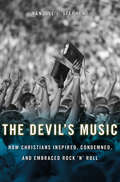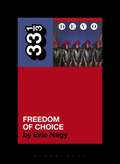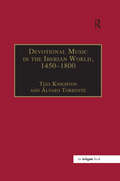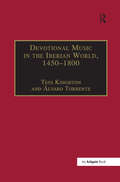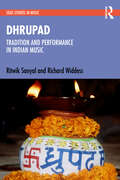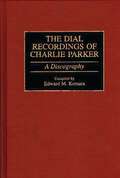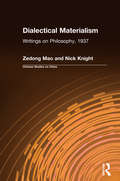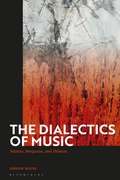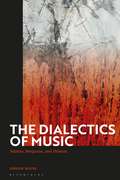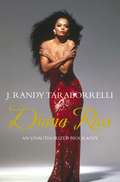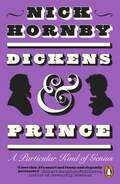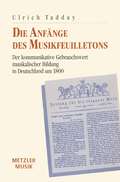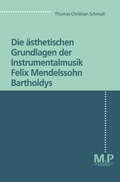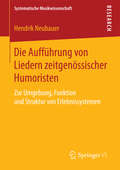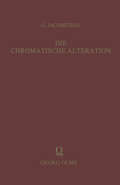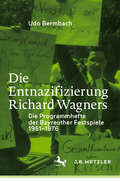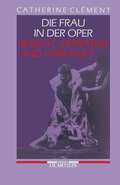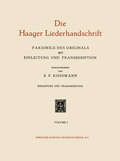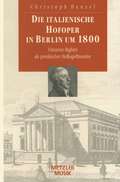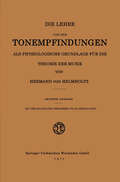- Table View
- List View
The Devil’s Music: How Christians Inspired, Condemned, and Embraced Rock ’n’ Roll
by Randall J. StephensWhen rock ’n’ roll emerged in the 1950s, ministers denounced it from their pulpits and Sunday school teachers warned of the music’s demonic origins. The big beat, said Billy Graham, was “ever working in the world for evil.” Yet by the early 2000s Christian rock had become a billion-dollar industry. The Devil’s Music tells the story of this transformation. Rock’s origins lie in part with the energetic Southern Pentecostal churches where Elvis, Little Richard, James Brown, and other pioneers of the genre worshipped as children. Randall J. Stephens shows that the music, styles, and ideas of tongue-speaking churches powerfully influenced these early performers. As rock ’n’ roll’s popularity grew, white preachers tried to distance their flock from this “blasphemous jungle music,” with little success. By the 1960s, Christian leaders feared the Beatles really were more popular than Jesus, as John Lennon claimed. Stephens argues that in the early days of rock ’n’ roll, faith served as a vehicle for whites’ racial fears. A decade later, evangelical Christians were at odds with the counterculture and the antiwar movement. By associating the music of blacks and hippies with godlessness, believers used their faith to justify racism and conservative politics. But in a reversal of strategy in the early 1970s, the same evangelicals embraced Christian rock as a way to express Jesus’s message within their own religious community and project it into a secular world. In Stephens’s compelling narrative, the result was a powerful fusion of conservatism and popular culture whose effects are still felt today.
The Devil’s Music: How Christians Inspired, Condemned, and Embraced Rock ’n’ Roll
by Randall J. StephensWhen rock ’n’ roll emerged in the 1950s, ministers denounced it from their pulpits and Sunday school teachers warned of the music’s demonic origins. The big beat, said Billy Graham, was “ever working in the world for evil.” Yet by the early 2000s Christian rock had become a billion-dollar industry. The Devil’s Music tells the story of this transformation. Rock’s origins lie in part with the energetic Southern Pentecostal churches where Elvis, Little Richard, James Brown, and other pioneers of the genre worshipped as children. Randall J. Stephens shows that the music, styles, and ideas of tongue-speaking churches powerfully influenced these early performers. As rock ’n’ roll’s popularity grew, white preachers tried to distance their flock from this “blasphemous jungle music,” with little success. By the 1960s, Christian leaders feared the Beatles really were more popular than Jesus, as John Lennon claimed. Stephens argues that in the early days of rock ’n’ roll, faith served as a vehicle for whites’ racial fears. A decade later, evangelical Christians were at odds with the counterculture and the antiwar movement. By associating the music of blacks and hippies with godlessness, believers used their faith to justify racism and conservative politics. But in a reversal of strategy in the early 1970s, the same evangelicals embraced Christian rock as a way to express Jesus’s message within their own religious community and project it into a secular world. In Stephens’s compelling narrative, the result was a powerful fusion of conservatism and popular culture whose effects are still felt today.
Devo's Freedom of Choice (33 1/3)
by Fred Armisen Evie NagyFinally, after all that waiting, The Future arrived in 1980. Ohio art-rockers Devo had plainly prepared with their 1979 second LP Duty Now for the Future, and now it was go time. Propelled by the new decade's high-tech, free-market, pre-AIDS promise, 1980's Freedom of Choice would rocket what Devo co-founder Gerald Casale calls his "alternate universe, hermetically sealed, alien band" both into the arms of the Earthlings and back to their home planet in one scenic trip.Before an artistic and commercial decline that resulted in a 20-year gap between Devo's last two studio records, Freedom of Choice made them curious, insurgent superstars, vindicated but ultimately betrayed by the birth of MTV. Their only platinum album represented the best of their unreplicable code: dead-serious tricksters, embracing conformity in order to destroy it with bullet-proof pop sensibility. Through first-hand accounts from the band and musical analysis set against an examination of new wave's emergence, the first-ever authorized book about Devo (with a foreword by Portlandia's Fred Armisen) explores the group's peak of success, when their hermetic seal cracked open to let in mainstream attention, a legion of new Devotees, and plenty of misunderstandings. "Freedom of Choice was the end of Devo innocence–it turned out to be the high point before the s***storm of a total cultural move to the right, the advent of AIDS, and the press starting to figure Devo out and think they had our number," says Casale. "It's where everything changes."
Devo's Freedom of Choice (33 1/3)
by Fred Armisen Evie NagyFinally, after all that waiting, The Future arrived in 1980. Ohio art-rockers Devo had plainly prepared with their 1979 second LP Duty Now for the Future, and now it was go time. Propelled by the new decade's high-tech, free-market, pre-AIDS promise, 1980's Freedom of Choice would rocket what Devo co-founder Gerald Casale calls his "alternate universe, hermetically sealed, alien band" both into the arms of the Earthlings and back to their home planet in one scenic trip.Before an artistic and commercial decline that resulted in a 20-year gap between Devo's last two studio records, Freedom of Choice made them curious, insurgent superstars, vindicated but ultimately betrayed by the birth of MTV. Their only platinum album represented the best of their unreplicable code: dead-serious tricksters, embracing conformity in order to destroy it with bullet-proof pop sensibility. Through first-hand accounts from the band and musical analysis set against an examination of new wave's emergence, the first-ever authorized book about Devo (with a foreword by Portlandia's Fred Armisen) explores the group's peak of success, when their hermetic seal cracked open to let in mainstream attention, a legion of new Devotees, and plenty of misunderstandings. "Freedom of Choice was the end of Devo innocence–it turned out to be the high point before the s***storm of a total cultural move to the right, the advent of AIDS, and the press starting to figure Devo out and think they had our number," says Casale. "It's where everything changes."
Devotional Music In The Iberian World, 1450-1800: The Villancico And Related Genres
by Álvaro Torrente Tess KnightonFrom the fifteenth century to the beginning of the nineteenth century, devotional music played a fundamental role in the Iberian world. Songs in the vernacular, usually referred to by the generic name of 'villancico', but including forms as varied as madrigals, ensaladas, tonos, cantatas or even oratorios, were regularly performed at many religious feasts in major churches, royal and private chapels, convents and in monasteries. These compositions appear to have progressively fulfilled or supplemented the role occupied by the Latin motet in other countries and, as they were often composed anew for each celebration, the surviving sources vastly outnumber those of Latin compositions; they can be counted in tens of thousands. The close relationship with secular genres, both musical, literary and performative, turned these compositions into a major vehicle for dissemination of vernacular styles throughout the Iberian world. This model of musical production was also cultivated in Portugal and rapidly exported to the Spanish and Portuguese colonies in America and Asia. In many cases, the villancico repertory represents the oldest surviving source of music produced in these regions, thus affording it a primary role in the construction of national identities. The sixteen essays in this volume explore the development of devotional music in the Iberian world in this period, providing the first broad-based survey of this important genre.
Devotional Music in the Iberian World, 1450-1800: The Villancico and Related Genres
by Tess KnightonFrom the fifteenth century to the beginning of the nineteenth century, devotional music played a fundamental role in the Iberian world. Songs in the vernacular, usually referred to by the generic name of 'villancico', but including forms as varied as madrigals, ensaladas, tonos, cantatas or even oratorios, were regularly performed at many religious feasts in major churches, royal and private chapels, convents and in monasteries. These compositions appear to have progressively fulfilled or supplemented the role occupied by the Latin motet in other countries and, as they were often composed anew for each celebration, the surviving sources vastly outnumber those of Latin compositions; they can be counted in tens of thousands. The close relationship with secular genres, both musical, literary and performative, turned these compositions into a major vehicle for dissemination of vernacular styles throughout the Iberian world. This model of musical production was also cultivated in Portugal and rapidly exported to the Spanish and Portuguese colonies in America and Asia. In many cases, the villancico repertory represents the oldest surviving source of music produced in these regions, thus affording it a primary role in the construction of national identities. The sixteen essays in this volume explore the development of devotional music in the Iberian world in this period, providing the first broad-based survey of this important genre.
Devotional Music in the Iberian World, 1450-1800: The Villancico and Related Genres
by TESS KNIGHTON AND ÁLVARO TORRENTEFrom the fifteenth century to the beginning of the nineteenth century, devotional music played a fundamental role in the Iberian world. Songs in the vernacular, usually referred to by the generic name of 'villancico', but including forms as varied as madrigals, ensaladas, tonos, cantatas or even oratorios, were regularly performed at many religious feasts in major churches, royal and private chapels, convents and in monasteries. These compositions appear to have progressively fulfilled or supplemented the role occupied by the Latin motet in other countries and, as they were often composed anew for each celebration, the surviving sources vastly outnumber those of Latin compositions; they can be counted in tens of thousands. The close relationship with secular genres, both musical, literary and performative, turned these compositions into a major vehicle for dissemination of vernacular styles throughout the Iberian world. This model of musical production was also cultivated in Portugal and rapidly exported to the Spanish and Portuguese colonies in America and Asia. In many cases, the villancico repertory represents the oldest surviving source of music produced in these regions, thus affording it a primary role in the construction of national identities. The sixteen essays in this volume explore the development of devotional music in the Iberian world in this period, providing the first broad-based survey of this important genre.
Dhrupad: Tradition and Performance in Indian Music (SOAS Studies in Music)
by Ritwik Sanyal Richard WiddessDhrupad is believed to be the oldest style of classical vocal music performed today in North India. This detailed study of the genre considers the relationship between the oral tradition, its transmission from generation to generation, and its re-creation in performance. There is an overview of the historical development of the dhrupad tradition and its performance style from the sixteenth to the nineteenth centuries, and of the musical lineages that carried it forward into the twentieth century, followed by analyses of performance techniques, processes and styles. The authors examine the relationship between the structures provided by tradition and their realization by the performer to throw light on the nature of tradition and creativity in Indian music; and the book ends with an account of the ‘revival’ movement of the late twentieth century that re-established the genre in new contexts. Augmented with an analytical transcription of a complete dhrupad performance, this is the first book-length study of an Indian vocal genre to be co-authored by an Indian practitioner and a Western musicologist.
The Dial Recordings of Charlie Parker: A Discography (Discographies: Association for Recorded Sound Collections Discographic Reference)
by Edward KomaraDial Records catered to jazz musicians and record collectors. Charlie Parker was one of the major jazz artists to record with Dial. His Dial sessions occurred at the personal depths and artistic peaks of his career during which he introduced a number of such jazz staples as Ornithology and Scrapple from the Apple. His ten sessions associated with Dial are presented in detail and include the repertory, original issues and reissues, titles and notated transcriptions, and analyses of performances. Commentary explains many of the titles to Parker's pieces and collates the various recordings in which he performed his Dial repertory outside the confines of the Dial studios; these celebrated performances helped to shape modern jazz.In addition to the catalogue of Parker's Dial recordings, jazz historians and scholars alike will appreciate the historical narrative detailing the evolution of Dial Records, its owner Ross Russell, and its business relations with Charlie Parker. This examination of the 1940's jazz record business sheds light on the dissemination of jazz via records. Five appendices complete this well organized and thorough study of Charlie Parker and his legendary Dial recordings.
Dialectical Materialism: Writings on Philosophy, 1937
by Zedong Mao Nick KnightNew and annotated translations of philosophical essays written by Mao Zedong in 1937, which have come to be regarded as a cornerstone in the development of Chinese Marxism. The editor analyzes their textual, philosophical and historical significance.
Dialectical Materialism: Writings on Philosophy, 1937
by Zedong Mao Nick KnightNew and annotated translations of philosophical essays written by Mao Zedong in 1937, which have come to be regarded as a cornerstone in the development of Chinese Marxism. The editor analyzes their textual, philosophical and historical significance.
The Dialectics of Music: Adorno, Benjamin, and Deleuze
by Joseph WeissCombining the philosophy and musicology of T.W. Adorno, Walter Benjamin, and Gilles Deleuze, alongside an exploration of the dialectical character of music production Joseph Weiss exposes the unresolved contradictions of contemporary music.By following the outermost mediations between nature, history, and technology, the book reflects on how advanced music critically responds to the ongoing catastrophe of both the Middle Passage and Auschwitz. Following what the author calls the “categorical imperative” of music, Weiss investigates the significance of a wide range of musical phenomena including the territorialization of the lullaby, the improvisation and sorrow song of the blues and jazz, as well as the cosmological limits of the electroacoustic avant-garde. In the era of commodity production, racialized violence and dispossession, the author defends critical music as a singular index of political possibilities.
The Dialectics of Music: Adorno, Benjamin, and Deleuze
by Joseph WeissCombining the philosophy and musicology of T.W. Adorno, Walter Benjamin, and Gilles Deleuze, alongside an exploration of the dialectical character of music production Joseph Weiss exposes the unresolved contradictions of contemporary music.By following the outermost mediations between nature, history, and technology, the book reflects on how advanced music critically responds to the ongoing catastrophe of both the Middle Passage and Auschwitz. Following what the author calls the “categorical imperative” of music, Weiss investigates the significance of a wide range of musical phenomena including the territorialization of the lullaby, the improvisation and sorrow song of the blues and jazz, as well as the cosmological limits of the electroacoustic avant-garde. In the era of commodity production, racialized violence and dispossession, the author defends critical music as a singular index of political possibilities.
Diana Ross: An Unauthorized Biography
by J. Randy TaraborrelliDiana Ross was raised in the Detroit projects and, through hard work and determination, scaled the heights of superstardom, first as lead singer of the Supremes and then as a solo artist. To this day she remains the grand diva against which all others in showbusiness are measured. This acclaimed biography reveals stunning new details about her combative relationship with the other Supremes, her passionate romance with Berry Gordy, president of Motown, which produced her very own 'love child', her two marriages and divorces, her recent arrest for drunk driving and her inspiring recovery. Drawing on hundreds of interviews, Taraborrelli paints an unforgettable picture of an extraordinary star. Diana is a Civil Rights trailblazer, a temperamental celebrity, a consummate entertainer, a loving mother. There is only one Diana Ross. And this is her story. 'For this admirably balanced, nuanced and respectful - yes respectful - examination of her life, Diana Ross should be grateful to J. Randy Taraborrelli. His credentials are excellent, as is the source of his cumulative labours . . . grips to the very last page' Sunday Times
Dickens and Prince: A Particular Kind of Genius
by Nick HornbyWhat could possibly connect Prince, the great twentieth century singer songwriter, and Charles Dickens, the great writer of classics usually stuffed into the hands of adolescents too early? What could these two geniuses, one born in 1812 in England, and the other in 1950s Minneapolis, have in common?For Nick Hornby, Dickens and Prince are two artists that compare to no others. At the young age of 24, they both had their breakthroughs, Prince with '1999' and Dickens with The Pickwick Papers. At 26, Prince released 'Purple Rain' and Dickens' Oliver Twist was published, and, by 30, both artists were huge stars.No one else had such a relentless work ethic and produced such a staggeringly original and enormous body of work. Where did their magic come from? How did they use it? And, in the end, did it kill them?Tracing their lives, from the early years to their relationships with women, their finances to their inability to stop working, Dickens and Prince is a brilliantly surprising and joyous uncovering of the essence of a very particular and unique type of genius.
Die Anfänge des Musikfeuilletons: Der kommunikative Gebrauchswert musikalischer Bildung in Deutschland um 1800
by Ulrich TaddayDie ästhetischen Grundlagen der Instrumentalmusik Felix Mendelssohn Bartholdys: M&P Schriftenreihe
by Thomas Christian SchmidtDie Aufführung von Liedern zeitgenössischer Humoristen: Zur Umgebung, Funktion und Struktur von Erlebnissystemen (Systematische Musikwissenschaft)
by Hendrik NeubauerIn diesem Buch befasst sich Hendrik Neubauer mit dem musikalischen Ereignis der humoristisch ausgerichteten Kleinkunst. Seine empirische Untersuchung ergibt, dass die Spielereignisse in Verbindung mit den Humoristen Helge Schneider, Mike Krüger und Rainald Grebe als individuelle Erlebnissysteme aufzufassen sind. Charakteristisch ist dabei, dass es sich bei den jeweiligen Spielereignissen um interaktive Originale handelt. Die Humorempfindung hängt von der Qualität der Gestaltung der Aufführung/Performance ab. Die Eigenschaften der hier herausgearbeiteten Erlebnissysteme können mit denen anderer kultursoziologischen Systemmodelle der Postmoderne verglichen werden, um Gesellschaftstrends aufzuspüren.
Die Entnazifizierung Richard Wagners: Die Programmhefte der Bayreuther Festspiele 1951-1976
by Udo BermbachDie Bayreuther Festspiele, während des Dritten Reiches „Hitlers Hoftheater“ (Th. Mann), schienen nach dem Zweiten Weltkrieg am Ende und Wagner selbst unheilbar beschädigt. Als 1951 die Bayreuther Festspiele von den Wagner-Enkeln Wieland und Wolfgang doch wiedereröffnet wurden, war dies nur möglich durch einen radikalen ästhetischen wie weltanschaulichen Bruch mit der Vergangenheit. Auf der Bühne wie in den Programmheften der Festspiele vollzog sich der Wandel zu einem neuen Wagner-Verständnis. Anfangs schrieben die alten NS-Autoren auf Wielands Einladung weiter, allerdings mit neuen Themen, und nur allmählich kamen neue Autoren wie Ernst Bloch, Hans Mayer und Theodor W. Adorno hinzu, die das überkommene, völkisch-nationalistische Wagnerbild durch ein modernes ersetzten: Wagner wurde zum Zeitgenossen, der die kapitalistische Gegenwart in starken Texten und Bildern kritisierte. Der Chéreau-Ring von 1976 markierte den Kulminationspunkt dieser Entwicklung. In seinem neuen Wagner-Buch liest Udo Bermbach die Programmhefte der Bayreuther Festspiele auch als Spiegel des intellektuellen Klimas der jungen Bundesrepublik.
Die Haager Liederhandschrift
by E.F. KossmannDieser Buchtitel ist Teil des Digitalisierungsprojekts Springer Book Archives mit Publikationen, die seit den Anfängen des Verlags von 1842 erschienen sind. Der Verlag stellt mit diesem Archiv Quellen für die historische wie auch die disziplingeschichtliche Forschung zur Verfügung, die jeweils im historischen Kontext betrachtet werden müssen. Dieser Titel erschien in der Zeit vor 1945 und wird daher in seiner zeittypischen politisch-ideologischen Ausrichtung vom Verlag nicht beworben.
Die italienische Hofoper in Berlin um 1800: Vincenzo Righini als preußischer Hofkapellmeister
by Christoph HenzelDie Kunst der Dauer: Transformative Erhabenheit in der zeitgenössischen Musik (Musik und Klangkultur #61)
by Sonja HeyerErhabenheit scheint ein angestaubtes ästhetisches Konzept zu sein. Doch Musik und Klangkunst konfrontieren uns seit dem 20. Jahrhundert mit Werken, in denen Stille und lange Dauern selbst zu überwältigenden Akteuren werden. Sonja Heyer entwickelt aus der Akteur-Netzwerk-Theorie und dem kritischen Posthumanismus das Konzept der transformativen Erhabenheit. Darin überlässt sich der Mensch nicht einer metaphysischen Ewigkeit, sondern wird Teil eines lebendigen ästhetischen Netzwerkes. Neben Werkanalysen dienen auch erstmalig veröffentlichte Interviews mit Mitgliedern der Komponistengruppe Wandelweiser der empirischen Fundierung dieser neuen Entwicklung in der zeitgenössischen Musik.
Die Lehre von den Tonempfindungen als Physiologische Grundlage für die Theorie der Musik
by Hermann von HelmholtzDieser Buchtitel ist Teil des Digitalisierungsprojekts Springer Book Archives mit Publikationen, die seit den Anfängen des Verlags von 1842 erschienen sind. Der Verlag stellt mit diesem Archiv Quellen für die historische wie auch die disziplingeschichtliche Forschung zur Verfügung, die jeweils im historischen Kontext betrachtet werden müssen. Dieser Titel erschien in der Zeit vor 1945 und wird daher in seiner zeittypischen politisch-ideologischen Ausrichtung vom Verlag nicht beworben.

